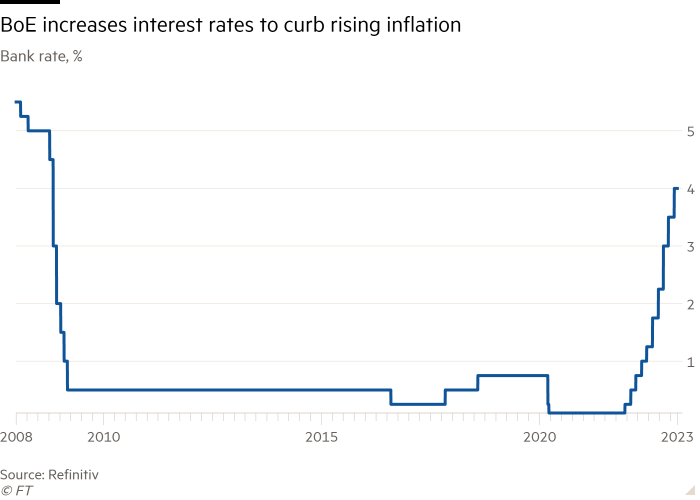The writer is professor of economics and finance at UCL and director of the UCL Centre for Finance
Globally, banks have been posting record increases in profits in 2022. In the UK for instance, Lloyds announced that profits almost doubled. One may wonder how bank profits can dramatically go up during a monetary policy tightening cycle.
After all, banks are supposed to do maturity transformation: borrow short term and lend long term. When interest rates are going up sharply, this suggests a fall in net interest income and therefore a decrease in profits.
In fact, net interest income for banks has dramatically gone up recently and is by far the key reason for the surge in bank profit. The increase in net interest margins in 2021-22 accounts for 60 per cent of the surge in profits, according to a recent report by McKinsey.
Over the past five quarters, the Bank of England’s benchmark base rate went from 0.1 per cent to 4 per cent. While policy interest rate rises are quickly passed on to borrowers (as anyone with a mortgage well knows), they are barely transmitted to savers.
As UK readers are probably aware, deposits rates went up only modestly since the beginning of the tightening cycle: the standard rates offered by the main British high street banks are still below 1 per cent (they were essentially at zero a year ago). But banks can now earn a base rate of 4 per cent by parking deposits at the central bank.
One could expect one of these banks to compete to attract deposits by bidding up rates to take market share, say offering 2 per cent. Then another bank would bid up further, say to 2.5 per cent, and so on. Ultimately, competition would then bring the deposit rate closer to 4 per cent.
The rate wouldn’t reach 4 per cent because the banks face costs of providing the services, but such costs are likely to be in basis points, rather than in per cents. Some closing of the gap should be expected in a competitive industry. That it does not happen is a strong sign of lack of competition and it is the main reason why bank profits go up when central banks sharply tighten monetary policy.
The reason why competition does not play out here is not obvious as there seem to be enough banks, in principle to trigger such mechanisms. However, it is also true that the market is dominated by a small number of big players. Given that deposits are notoriously sticky (savers do not have the habit to shop around for better rates) it may be the case that no major player has an incentive to deviate and offer higher rates, as long as the others do not either.
Lack of competition is an issue in general. While market power generates extra profits for shareholders and large compensations for managers, it makes consumers worse off. It also hurts the economy as a whole because the losses to consumers are greater than the gains for the firm. Beyond this traditional argument, there are here two additional concerns. Fortunately, there is also a simple remedy.
The concerns are linked to high inflation. First, high inflation is the reason for nominal rate increases. But if increases are only partially transmitted to the real economy, higher nominal rates are likely to be needed to achieve the same tightening. In short, the lack of competition in the deposit sector impairs the transmission of monetary policy.

Second, high inflation tends to disproportionally affect less financially sophisticated household. Such households are more likely to keep their savings as deposits than to invest them in bank equity for instance. If saving rates kept pace with nominal rate rises, this would mitigate the problem. Instead, the lack of competition in the deposit sector magnifies the cost of living crisis.
The solution is simple: make interest payment on reserves conditional on banks passing the higher rates to depositors. For instance, the central bank could set a maximum margin as a condition.
This is something it can do and should do, as this would improve the transmission of monetary policy, thereby making it easier to deliver on its price stability mandate. It would also help ease the burden on consumers during what BoE governor Andrew Bailey acknowledged this week as a cost of living crisis for many people. At the time when central bankers’ jobs is to take painful yet needed decisions, a simple reform that goes towards both easing their task and helping the public shouldn’t be overlooked.






